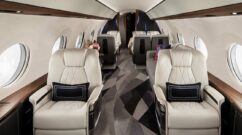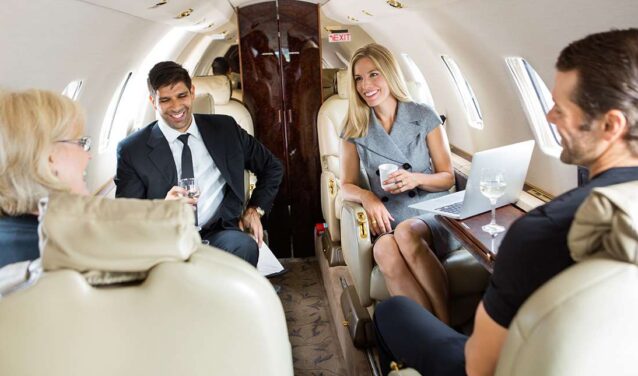Jet sharing or seat sales: an introduction
In the world of business aviation, the concept of ” Jet Sharing ” (sharing seats on board a private flight) marks a significant evolution. It is perfectly in line with AEROAFFAIRES’ commitment to innovation: maximizing efficiency, offering alternatives and optimizing aircraft use. The logic is simple yet powerful: a customer books a private jet flight, confirms the aircraft, and can then offer on a platform the seats he won’t be using; external passengers then purchase these seats at a set price. Once the flight has been confirmed, the aircraft positioned and the logistics validated, everyone benefits.
A mechanism to give access to “empty seats” on flights already confirmed, or Empty Legs.
This type of offer merits in-depth examination: competitive advantage, constraints, suitability for our executive customers, implementation conditions. This article explores the subject in detail.
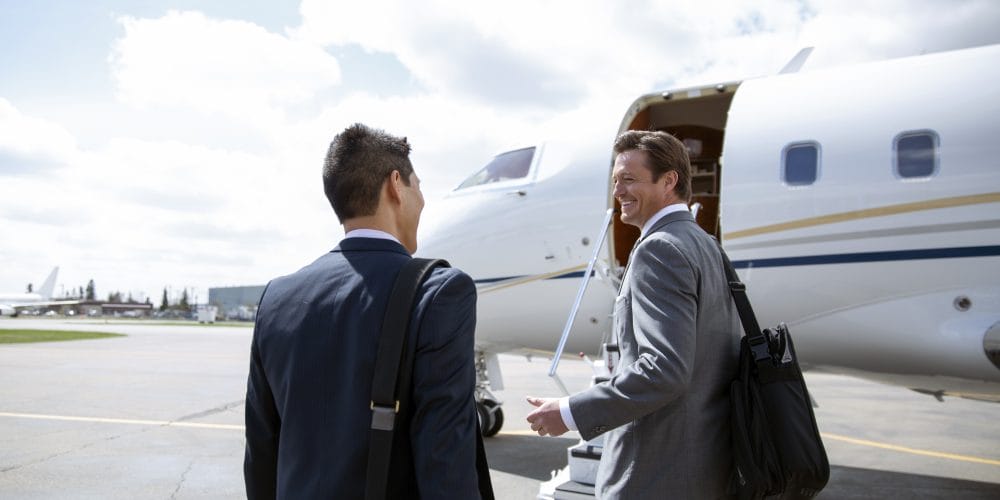
1. Jet Sharing with AEROAFFAIRES: an exclusive service to enhance the value of every private flight
In business aviation, there are innovations that immediately change the way people travel. Jet Sharing is one of them. At AEROAFFAIRES, we have conceived it as a natural extension of our business: to accompany our executive customers with smarter, more flexible and sometimes more economical solutions, without ever compromising the quality for which we are renowned.
The idea is simple. When you charter a private jet, it happens that several seats remain unoccupied. The flight is confirmed, the crew ready, the itinerary set. Jet Sharing now lets you turn those empty seats into an opportunity: they can be offered to other selected travelers, who will join your aircraft for that precise journey. Nothing changes for you. Your schedule remains the same. Your comfort level too. But part of the cost of the flight is absorbed by these shared seats.
For some of our customers, it’s an elegant way to add value to a trip they’re already making. For others, it’s a gateway to the private cabin, at a more affordable fare. For us, it’s a coherent way of making business aviation more efficient, more responsible and better adapted to new uses.
1.1 Why Jet Sharing?
With a traditional private jet charter, a customer reserves the entire aircraft, regardless of the number of people on board. This implies high charges, sometimes disproportionate if the aircraft is not full. Empty flights or repositioning segments generate a cost without passengers.
Jet Sharing responds to these realities:
- Optimize the use of an aircraft already scheduled or booked.
- Enable new customers to access the private cabin without bearing the full cost.
- For the original customer, reduce flight costs by selling unused seats.
1.2 Why AEROAFFAIRES is launching Jet Sharing
For more than thirty years, we’ve been seeing the same situations: executives leaving alone for a strategic meeting; a team reducing its delegation at the last minute; a repositioned aircraft leaving an airport with empty seats. These flights are necessary and perfectly justified, but their potential is not always fully utilized.
We have therefore developed a service that does not replace exclusive charter, but offers an alternative in situations where several seats could be used. This approach meets three recurring customer expectations: optimizing their budget, making their travel more flexible, and adopting a more responsible approach to mobility.
Jet Sharing fits exactly into this dynamic, while scrupulously respecting our standards of safety, confidentiality and discretion. You remain in control of your flight. Nothing is changed without your agreement.
1.3 How AEROAFFAIRES Jet Sharing works
When a customer confirms a flight, our advisors work with him or her to identify the number of seats likely to be offered. It’s a straightforward exchange based on mission analysis. If you wish, these seats are then made available on a private platform, operated by AEROAFFAIRES, where only verified passengers can make a reservation.
Travelers who purchase a seat comply with the same requirements as any passenger on a private flight. They board in the same dedicated lounge, undergo the same checks, and enjoy the same level of service. The flight itself remains focused on your needs. The schedule doesn’t change. Nor does the itinerary. You retain priority over all operational aspects.
This system is based on a highly structured logic: certified aircraft, qualified crews, rigorous control of each passenger, clear baggage guidelines, coordinated access, management of travel documents and transparency on seat pricing. Nothing is left to chance; it’s a prerequisite for maintaining the level of quality that characterizes our work.
1.4 A solution designed for executives and their teams
For executives who travel regularly, Jet Sharing represents a concrete way of balancing cost and performance. Some use this service when they travel alone; others when they organize a team trip that doesn’t take up all available seats. Jet Sharing can also be used to integrate an employee or partner at the last minute, without changing the original aircraft.
Concierge services and executive assistants see this as an additional advantage: they can manage more varied and sometimes more frequent mobility, while maintaining the high standards demanded by their management teams. For individual travelers, it’s a rare opportunity to access the cabin of a private jet without having to charter the entire aircraft, creating more flexible and accessible situations.
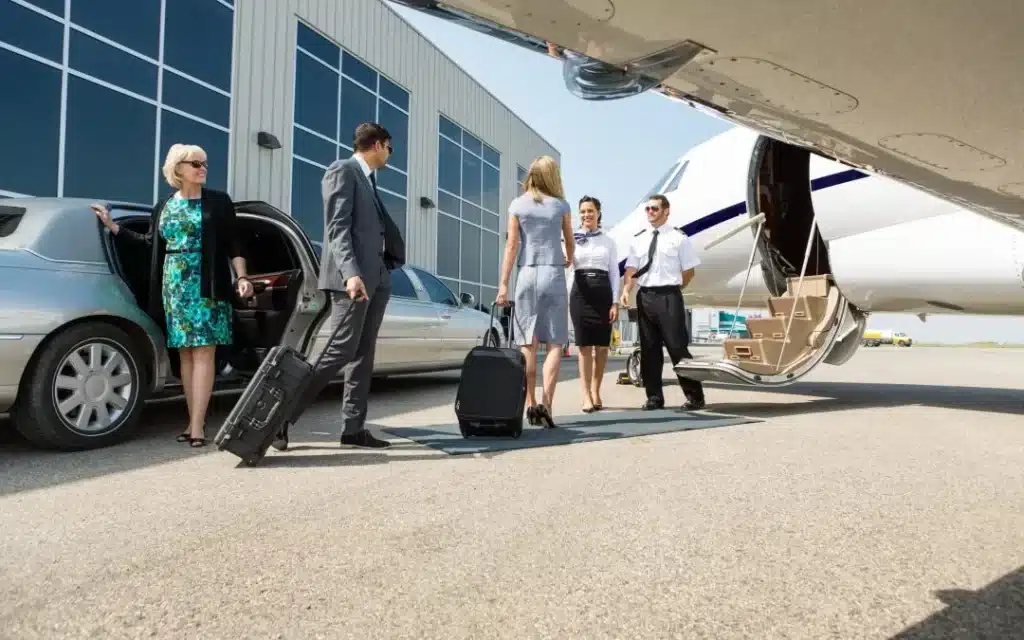
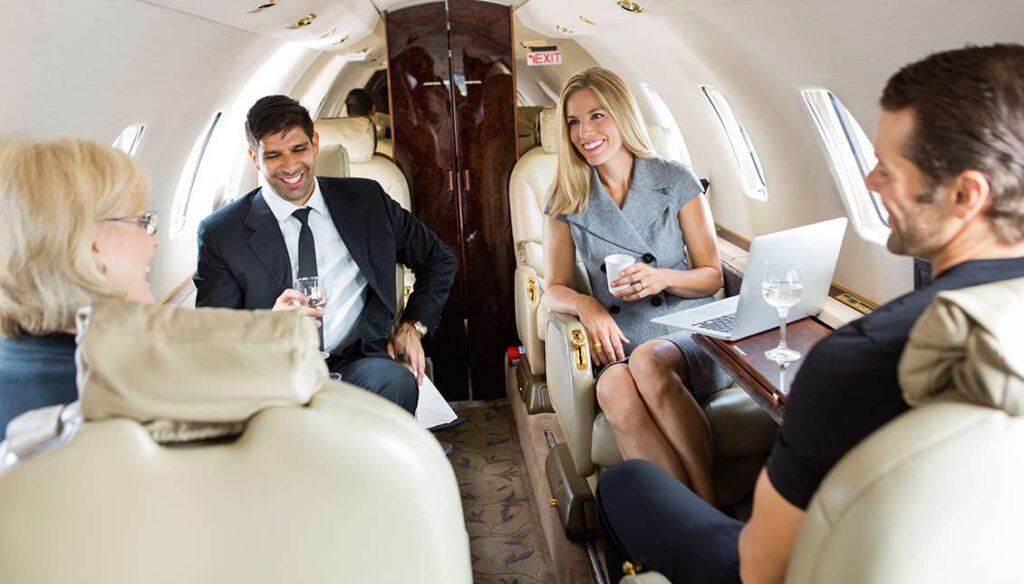
2. Jet Sharing in the AEROAFFAIRES strategy
We have structured this service with the same attention to detail as for our medical flights, helicopter transfers or group flights: clear governance, a secure platform, dedicated advisors and quality monitoring. We also implement precise monitoring to assess the rate of seats recovered, the experience of secondary passengers and the effective cost reduction for charter customers.
This approach also strengthens our environmental commitment. A better-filled aircraft means a more efficient flight. Every seat used improves the carbon ratio per passenger. This point is now on the minds of many executives, and is a natural part of Jet Sharing.
2.1 Recent examples
On a Paris-New York flight chartered for six people, two seats were offered for Jet Sharing, significantly reducing the total cost of the trip.
On a Geneva-London trip taken by a single executive, two shared seats paid for recurring journeys on a regular basis.
Other customers use this option on empty returns from the Côte d’Azur orItaly, with an immediate effect on their annual mobility budget.
3. How Jet Sharing works
3.1 The step-by-step mechanism
- A customer books a private jet flight via AEROAFFAIRES.
- The private jet is confirmed, and the itinerary and timetable validated.
- The initial customer identifies seats he won’t be using (e.g. flight booked for 6 passengers, only 3 board).
- These free seats are put online (platform, application) with a chosen or recommended fare. Customers can resell unused seats on “their plane” at the price of their choice. These seats then become available on our platform.
- Passengers purchase these individual seats.
- The flight takes place as planned: same service standards, same operating levels. The original customer and the resold seats share the aircraft.
3.2 Operating conditions
To ensure service quality and safety, a number of conditions must be met:
- The private aircraft, crew and operation must be certified to business aviation standards.
- The flight must be confirmed. Seats must not be offered before confirmation, to avoid surprises. Only confirmed flights will be accessible on the platform.
- Secondary passengers must meet the same requirements as the initial customer (baggage, formalities, security, briefing, etc.).
- A clear and transparent pricing policy (seat price, cancellation conditions, liability).
- On-board service must remain consistent for all passengers, to preserve the premium experience and image.
- Data management (passenger list, security checks, IFR/EVASIS compliance) must be ensured.
3.3 Pricing and cost-sharing
The initial customer sets the resale price for unused seats. This price may vary according to demand, itinerary, aircraft and season. The principle is that the shared seat reduces the cost of the flight for the charterer. In turn, “shared seat” passengers benefit from a cost that is often much lower than traditional charter. One article reports a reduction of up to 70% for (very similar) co-sharing models
3.4 Examples of practical applications
- Business flight from Paris to Geneva. The initial customer boards alone, interested in two free seats. He places them on line at a preferential rate.
- Company vacation on a light jet between Nice and Ibiza: 4 seats out of 8 available, sold to “jet sharing” passengers.
- Empty return from the Côte d’Azur after a business trip: offer these seats to cover repositioning costs.
4. Use cases and benefits for high-end customers
4.1 Executives and concierge services
For executive customers, executive assistants and concierge services (a segment already covered by AEROAFFAIRES):
- Jet Sharing allows you to optimize your business budget while maintaining quality.
- It opens up access to private flights for a wider delegation, or to host employees at lower cost.
- It allows you to design a hybrid arrangement: private jet flight + additional seats for employees or partners.
- It reinforces environmental responsibility: by optimizing load factors, the carbon footprint is better amortized. This is in line with AEROAFFAIRES’ commitment to the environment.
4.2 International adaptation
With a network of 8,000+ aircraft and 20,000 international flights to date, AEROAFFAIRES has the ideal infrastructure to deploy this solution. On regular or recurring international flights, Jet Sharing opens up a dimension of global optimization.
4.3 Example of an optimized itinerary
Let’s imagine a Paris-Milan-Geneva flight. The initial customer reserves a super-medium aircraft for a delegation of 4 people. Two seats remain free. By offering these two seats as Jet Sharing, the customer reduces the hourly cost of the aircraft, and three entities benefit from the flight under premium conditions.
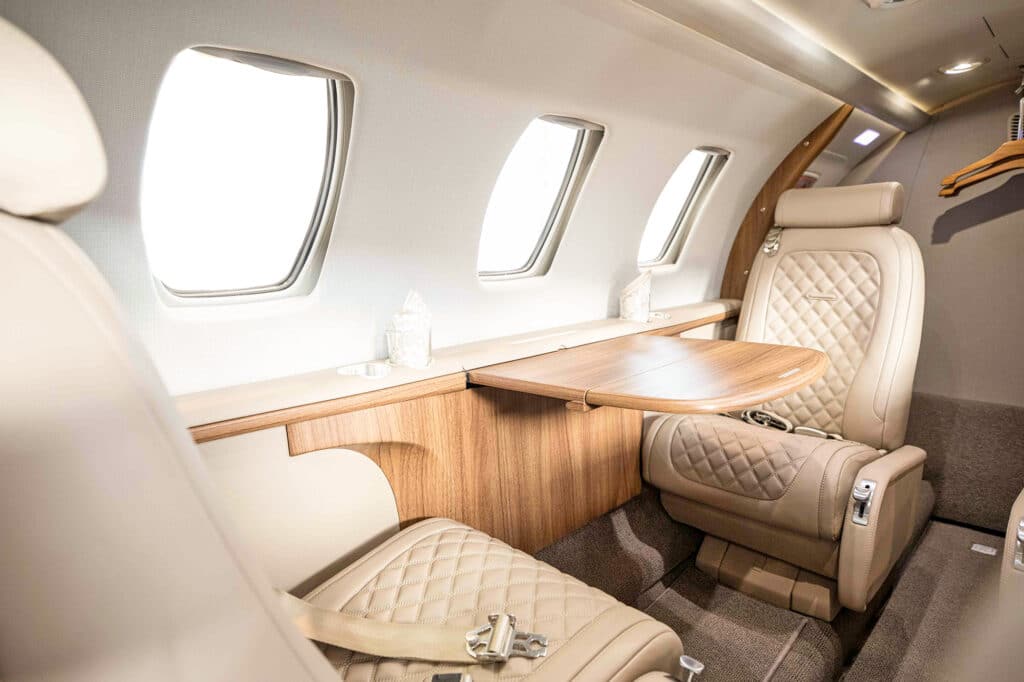

5. Constraints, limits and best practices
5.1 Reduced flexibility
The main compromise: the flight is confirmed by the initial customer, but secondary passengers must adhere to the schedule, itinerary and aircraft type imposed. This model is less flexible than pure charter.
Executives need to be aware that extreme personalization (choice of aircraft, itinerary modifications) can be reduced.
5.2 Pricing and value perception
If the price of a seat is too low, it may offend the “premium” perception. Accessibility and perceived value must be balanced. On-board experience, support and quality must not suffer.
5.3 Logistics and operational responsibility
- Secondary passenger management: checking baggage, access, compliance.
- Insurance and security: all passengers must be covered to the same standards.
- Flight cancellation or modification: contingency for resold seats.
- Transparency of purchase and cancellation conditions for shared seats.
5.4 Brand image and segmentation
For a player such as AEROAFFAIRES, the offer needs to be segmented:
- Classic” exclusive charter for very demanding customers.
- Jet Sharing for price-sensitive customers who want a private jet.
The shared offer must not be allowed to blur the ultra-prestige image.
5.5 Regulatory framework and compliance
Even with seat sharing, the operation must comply with air charter regulations, operating and safety certificates, and operational responsibility. The “jetpooling” model is mentioned on Wikipedia as a pro rata arrangement for sharing costs.
6. Limits to be aware of
This service is based on a fundamental principle: the flight remains that of the original customer. Secondary passengers adapt to their schedules. This is not an “à la carte” flight for them; it’s a seat on an existing flight. This fact must be clearly explained to avoid any confusion.
Another important point: shared seat pricing must reflect the spirit of private flight. Offering fares that are too low risks sending out the wrong signal. At AEROAFFAIRES, we advise our customers on how to set the right price, in line with the market and in keeping with the image of the private jet.
Finally, even if this service brings a real gain in efficiency, it must not blur the distinction between exclusive charter and shared seat. The two models meet different needs, and our role is to guide you towards the one that best serves your objectives.
A question? Contact our airline experts

Isabelle CLERC
CEO AEROAFFAIRES

François-Xavier CLERC
Founder AEROAFFAIRES
Our airline experts remain at your disposal to help you at every stage of your reservation.
Strategic integration at AEROAFFAIRES
Adjusted value proposition
For AEROAFFAIRES customers, we could articulate the “Jet Sharing AEROAFFAIRES” offer as follows:
- Access to individual private jet seats on confirmed flights.
- Reduced usage costs for the charter customer.
- Guaranteed service, certified operator, compliance with AEROAFFAIRES standards.
- Secure private seat resale platform for AEROAFFAIRES customers.
- Customized support (security, sensitive baggage, transfers).
Commercial terms and customer support
- Pre-flight: identification of available seats, communication to the resale platform.
- During flight: same level of service for all passengers.
- Post-flight: operational reporting, feedback, satisfaction monitoring.
- Clear pricing: the shared seat can be offered at a fixed or dynamic rate, depending on the itinerary.
- Appropriate communication: explain the difference between exclusive charter and shared seat, preserve the premium experience.
Market trends and outlook
Growth of the shared model
Jet Sharing is part of a broader trend: that of shared consumption (car sharing, car pooling) applied to aviation. One article notes “empty flights” and “seat rental” as emerging options.
Sustainability and environmental impact
Flight optimization (fewer empty aircraft) is part of a responsible approach. For AEROAFFAIRES, which already offsets the carbon footprint of its flights, this offer can reinforce its ESG posture.
Digitalization and internal platform
Technology is a key element in the management of empty seats, online booking, reservations and electronic signatures.
Changing customer expectations
Managers now expect flexibility, personalization and accessibility. Shared seating can meet some of these criteria without sacrificing quality. This adaptation can also broaden the customer base for private jet travel.
Case studies and feedback
Example between corporate partners
A Paris-based multinational books a flight from Paris to New York for 6 people. 2 seats remain free. Thanks to the resale of these two seats via Jet Sharing, the hourly cost of the jet is reduced by X%. The service remains identical, the route and aircraft unchanged. The chartering customer can capitalize on this optimization internally.
Example for a solo customer
An executive regularly travels alone between Geneva and London. He books a light jet for himself. He shares the 2 free seats. The secondary passengers board, and he amortizes a portion of the cost of the flight.
User experience feedback
Secondary passengers appreciate the access to the private cabin. However, some note the lesser flexibility (fixed schedules). This is the compromise that needs to be presented.
Recommendations for customers and partners
For charter customers
- Identify unused seats in advance.
- Clearly communicate fares and conditions to secondary passengers.
- Ensure that the aircraft and operator are up to standard.
- Consider cost optimization compared to traditional charter.
For secondary passengers
- Check flight availability and confirmation.
- Understand constraints (fixed schedules, non-modifiable itinerary).
- Confirm on-board services, baggage, formalities.
- Validate fare per seat and compare with alternatives.
For the broker / operator
- Clearly segment the offer (exclusive charter vs. shared seat).
- Train advisors to clearly explain the differences.
- Maintain service quality and premium image.
- Communicate the ecological and economic benefits.
Frequently asked questions about Jet Sharing with AEROAFFAIRES
What exactly is Jet Sharing?
Jet Sharing involves offering passengers an individual seat on board a private flight already confirmed by a charter customer. The charterer can resell the unused seats, and the secondary passengers have access to the private cabin without having to fully charter it.
What’s the difference between classic charter and Jet Sharing?
With a traditional charter, a customer reserves the entire aircraft. The cost is borne solely by the customer. With Jet Sharing, the aircraft is still reserved by the original customer, but unused seats are resold to third parties to share the cost.
What are the benefits of jet sharing for the charter customer?
They can reduce their flight costs by reselling unused seats, optimize aircraft utilization, and enjoy the same quality of service.
What are the benefits for the secondary jet-sharing passenger?
They have access to a private jet flight at a lower price, with all the advantages of a business jet (flexibility, comfort, time savings) without having to book the entire aircraft.
What are the first steps in formalizing a Jet Sharing offer at AEROAFFAIRES?
Define the internal process, create the seat resale platform, define pricing and conditions, train teams, and communicate with existing customers to test the offer.
Is this compatible with AEROAFFAIRES’ commitment to the environment?
Yes, by optimizing the use of seats and reducing empty runs, Jet Sharing contributes to greater energy efficiency and thus to a relative reduction in the carbon footprint per passenger.
How do you ensure quality and safety with jet sharing?
As with any private jet flight, both the aircraft and the operator must be certified (business aviation standards). The broker (like AEROAFFAIRES) ensures diligence, regulatory compliance and operational follow-up.
Are there compromises to be accepted for jet sharing?
Yes: fixed schedules and itineraries, less aircraft customization, dependence on the charter customer for flight confirmation, possibility of modification or cancellation.
How can I reduce the cost of a private jet flight?
The easiest way is to stop leaving seats unused. With Jet Sharing by AEROAFFAIRES, a customer who charters an aircraft can offer the seats he or she doesn’t occupy. The selected travelers buy an individual seat, and the amount paid directly reduces the cost of the original customer’s flight. Nothing changes for the customer: the schedule, aircraft and service remain identical.
Who offers Jet Sharing in France and Europe?
Jet Sharing by AEROAFFAIRES is offered by our team of aviation experts, with over thirty years’ experience. We operate this service on flights already confirmed by our customers, with strict operational monitoring and a private platform enabling certain seats to be made available to other qualified travelers.
How does AEROAFFAIRES select secondary passengers?
They undergo the same checks as any other business traveler: documents, identity, baggage conformity, access to the FBO. Our team ensures that they meet security standards and that their presence does not disrupt the flight or your confidentiality.
Is it possible to remain anonymous when using Jet Sharing?
Yes, the secondary passenger knows neither the identity of the charter customer, nor the reasons for the trip, nor the organizational details. AEROAFFAIRES acts as a filter: you remain totally protected.
How do I activate AEROAFFAIRES Jet Sharing for my next flight?
Simply tell your AEROAFFAIRES aviation expert when you’re preparing your mission. He or she identifies available seats, advises you on pricing, activates the broadcast on our private platform and follows up until boarding. The service is entirely turnkey.
Conclusion
Jet Sharing with AEROAFFAIRES is not just another product in a catalog. It’s a service designed to accompany customers for whom time, confidentiality and performance are essential. We’ve devised this model to add value to your missions, offer greater flexibility, and make each flight more relevant.
Our job remains the same: to listen, anticipate and adjust every detail.
Jet Sharing simply adds a new, elegant and controlled option to the way you travel.
If you’d like to activate it for your next flight, your AEROAFFAIRES consultant is at your disposal.
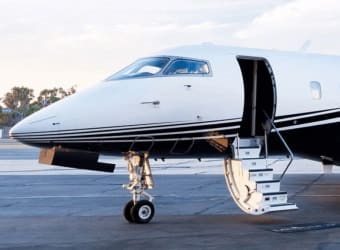
Need a price estimate?



